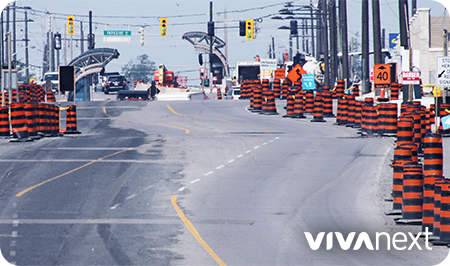Anyone who has driven with any regularity through one of our vivaNext construction zones will be familiar by now with the ongoing changes we periodically make to lane configurations, and the occasionally zig-zag layout of the temporary lanes. Here’s an explanation for those temporary lanes, and why they’re a necessary part of construction.
There’s no doubt that the fastest and easiest way to widen a road and build our BRT network would be to close the roads and divert all the traffic. Construction would be done soon and could even cost less. But Highway 7, Yonge Street and Davis Drive are among the busiest roads in York Region (which is why we’re building our first rapidways there). Any reduction to the number of lanes, even for a block, or for a short time, may result in traffic congestion and travel times, divert traffic into local neighbourhoods and hurt local businesses. Closures are only done for specific tasks, and only when there are no other reasonable options.
Widening the road and building the new rapidways can only be done when traffic is moved away. Even construction outside the roadway at the stations and boulevards requires extra space for safety and efficiency. Our project is complicated because we are building in the middle of live traffic lanes, so extra precautions are necessary.
The compromise is construction staging, meaning construction that’s done in individual steps or stages. Specific tasks requiring the same general work zone are carried out in one place at one time, before moving on to another area. To free up space, traffic is continually shifted, with temporary lanes moved around to accommodate active construction zones as our work progresses.
Creating a construction schedule and staging plan is a complex process, balancing community and project priorities. There are lots of considerations: maintaining traffic within the existing corridors rather than diverting traffic into adjacent neighbourhoods; minimizing disruption to drivers, local businesses and residents; working fast to finish on schedule so Viva rapidway service can begin.
Construction staging plans are developed block by block to include the timing and location of key construction activities, such as utility relocations; expansion or upgrading of critical infrastructure like watermains and sewers; road widening; building our rapidway stations; and constructing new features such as bike lanes and streetscaping elements. Preserving access to intersections, driveways and other important destinations is done to minimize impacts on residents and businesses. We also need to plan for specific construction requirements such as access for oversized construction equipment, or creating extra space around a short-term activity.
In general, we’ll do a set of tasks on one side of the road before the lanes are shifted (or “flipped”) for work to be done on the other side. And before traffic is shifted, we make sure the community and drivers are given plenty of advance notice so they know when travel lanes are going to be moved.
Ultimately, building a major construction project in the middle of a busy thoroughfare requires us all to share the road for a period of time. By staging our construction, we can ensure the safety and convenience of the community and drivers while keeping our crews safe so they can get the job done.

